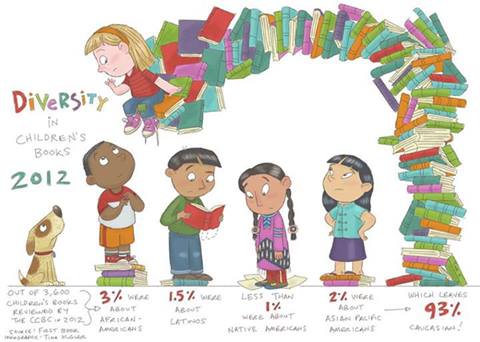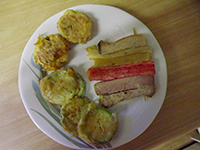|
Today is the Korean Thanksgiving called Chuseok, which lasts for three days. Each year I wonder if there are any story ideas lurking when I attend my in-law's activities. But so far, I haven't thought of any. Plus, someone else already wrote a marvelous picture book about the holiday. However, I'll still keep my eyes and ears open. By the way, in the photos above, the first picture shows practical gifts given, usually boxes of fruit, food, or shampoo/toothpaste sets wrapped in fancy silk cloths. The second picture shows some appetizers, sausage patties and zucchini patties dipped in egg, and the last is a skewer with mushroom, radish, crab, Spam, and fish. The last photo is Songpyon, traditional Thanksgiving rice cakes filled with crushed sesame seeds, sesame oil, and sugar. They're supposed to be in the shapes of a half moon to picture how the moon fills up, signifying that they hope their harvest is plenty. (at least that's what I read...my relatives made this food.) This got me to thinking today. Have you ever written a story that takes place in another culture? I've written about the Korean culture because I'm living and learning it. And I've written one story based on a true account of a similar culture to South Korea by conducting interviews, watching You Tube Videos, and reading lots of articles on the subject. (still to be published someday) If you've written about another culture that's not your own, what kind of research did you do? Watching video clips about the culture really helped me feel like I was there. Currently, my daughter is reading A Long Walk to Water by Linda Sue Park. I wondered how Linda Sue wrote this without visiting Sudan. Here's what I found on the web. While researching A Long Walk to Water I read Salva’s own accounts of his journey and interviewed him many times. For Nya’s part of the book, I had access to notes, photos, and video footage from people who had visited villages like hers (including my husband, who traveled to southern Sudan in 2009). I read several books about the Lost Boy refugees, watched documentaries and researched articles. Most important of all, of course, was my unrestricted access to Salva and his willingness to share his memories. ~Linda Sue Park http://www.uqp.uq.edu.au/skins/uqp/_uploads/TeachersNotes/A%20Long%20Walk%20to%20Water.pdf *** I've read how American publishers need and want to publish more multicultural books. What do you think of authors writing about a culture not their own? I know it's been discussed. You might have seen the illustration below circulating among the kid lit community. Something else to think about! 
Amazing illustration by artist Tina Kugler about the lack of diversity in children's literature in 2012. Kugler's illustration is based on the findings by the Cooperative Children's Book Center at the University Wisconsin-Madison which analyzed 3,600 last year and discovered that less than 8% of the total titles they received from publishers were about people of color.
11 Comments
My blog site received a face lift! What do you think? It's a new school year, and I've been taking new picture book classes, and so I figured it was time for a new blog look. So if you'd like to continue receiving my posts, please re-subscribe (located on the right). Thanks so much! And if you know of other links or perhaps your own blog that you'd like to have on my links page, please let me know. And now for a special treat..one of my critique partners, Hannah Holt of Portland, Oregon, just signed with agent Danielle Smith of Foreword Literary last month. I'm so happy for her. I wanted Hannah to share her story, and so I interviewed her.  Thanks again for having me over. :) -Hannah Tina: How did you get started? Hannah: One Christmas during graduate school, my husband and I didn't have money for presents, so I created handmade comic books. While I worked I wondered: what if I gave myself year to write a children's book? That was four years ago. Tina: Have you taken any writing classes that have helped you in your pb writing? Hannah: I took a poetry workshop from Linda Ashman, and I'd recommend it to anyone. But overall I'm pretty stingy selective when it comes to classes. My favorite writing resources are books, like WRITING WITH PICTURES (Uri Shulevitz) and WRITING PICTURE BOOKS (Ann Whitford Paul). Tina: How did you know which agents to submit to? Hannah: In the beginning, I didn't. My first round of queries was a random selection of agents from THE CHILDREN'S WRITER'S AND ILLUSTRATOR'S MARKET. (Rookie mistake!) It felt like playing roulette and resulted a bunch form rejections. After that ill conceived initial batch, I took a break from submitting to work on craft. I joined a few writing groups, and this crazy thing happened: my writing got better, and I made friends with other writers. When two of my friends signed with agent Danielle Smith, I started following her on twitter. I liked her right away. Tina: How did you nab an agent? Hannah: Well, because I followed Danielle on twitter, I knew about events she was participating in. My first attempt to catch her attention was at the #PitMad twitter party. She didn't bite. A few weeks later, I tried again during #PitchMas. This time she requested a manuscript. I sent it to her and heard nothing for over a month. While I was waiting, I signed up for WriteOnCon and posted a query in the forum. Danielle saw it and recognized my name from my previous query. She requested the second manuscript and offered representation within a week. Tina: Any advice to writers who are looking for agents? Hannah: Keep hope. Start something new while you are waiting (something other than a sequel!). Challenge yourself to write bigger, deeper, fresher. Find a balance between researching, networking, and writing. If you only have time for one thing... always choose writing! Tina: How do you know when your manuscript is ready to submit? Hannah: Critique groups help. My critique group always gives me great advice. Their feedback usually falls into one of four categories: 1) Not much enthusiasm & major revision suggestions 2) Not much enthusiasm & minor revision suggestions 3) Lots of enthusiasm & major revision suggestions 4) Lots of enthusiasm & minor revision suggestions Here is how I interpret it: 1) My idea stinks, and I executed it poorly. 2) My idea stinks, but I executed it decently. 3) My idea is okay, but I executed it poorly. 4) I am ready to submit. Thanks for having me over, Tina. Best wishes to everyone actively submitting! Good luck! -Hannah Hannah Holt is civil engineer turned picture book writer. She's a two-time Barbara Karlin Grant Letter of Merit recipient and Phillip E. Rollhaus essay winner. She lives in the Portland, Oregon with her husband Josh and their four young children. You can visit Hannah at her blog: www.LightbulbBooks.com Kid Crafts | Kitchen Play | Children's Literature Thanks, Hannah, for answering my questions. Hope this helps any of you who are agent-hunting! And thanks to all of you for stopping by! |
Tina M. Cho, children's authorI'm a children's author and freelance writer for the educational market. Welcome! Archives
March 2024
Categories
All
|







 RSS Feed
RSS Feed
